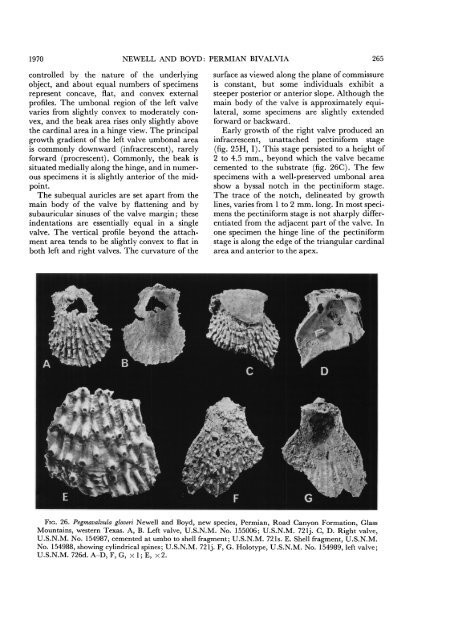IDY TE1>t' I- - American Museum of Natural History
IDY TE1>t' I- - American Museum of Natural History
IDY TE1>t' I- - American Museum of Natural History
Create successful ePaper yourself
Turn your PDF publications into a flip-book with our unique Google optimized e-Paper software.
1970<br />
controlled by the nature <strong>of</strong> the underlying<br />
object, and about equal numbers <strong>of</strong> specimens<br />
represent concave, flat, and convex external<br />
pr<strong>of</strong>iles. The umbonal region <strong>of</strong> the left valve<br />
varies from slightly convex to moderately convex,<br />
and the beak area rises only slightly above<br />
the cardinal area in a hinge view. The principal<br />
growth gradient <strong>of</strong> the left valve umbonal area<br />
is commonly downward (infracrescent), rarely<br />
forward (procrescent). Commonly, the beak is<br />
situated medially along the hinge, and in numerous<br />
specimens it is slightly anterior <strong>of</strong> the midpoint.<br />
The subequal auricles are set apart from the<br />
main body <strong>of</strong> the valve by flattening and by<br />
subauricular sinuses <strong>of</strong> the valve margin; these<br />
indentations are essentially equal in a single<br />
valve. The vertical pr<strong>of</strong>ile beyond the attachment<br />
area tends to be slightly convex to flat in<br />
both left and right valves. The curvature <strong>of</strong> the<br />
NEWELL AND BOYD: PERMIAN BIVALVIA<br />
surface as viewed along the plane <strong>of</strong> commissure<br />
is constant, but some individuals exhibit a<br />
steeper posterior or anterior slope. Although the<br />
main body <strong>of</strong> the valve is approximately equilateral,<br />
some specimens are slightly extended<br />
forward or backward.<br />
Early growth <strong>of</strong> the right valve produced an<br />
infracrescent, unattached pectiniform stage<br />
(fig. 25H, I). This stage persisted to a height <strong>of</strong><br />
2 to 4.5 mm., beyond which the valve became<br />
cemented to the substrate (fig. 26C). The few<br />
specimens with a well-preserved umbonal area<br />
show a byssal notch in the pectiniform stage.<br />
The trace <strong>of</strong> the notch, delineated by growth<br />
lines, varies from 1 to 2 mm. long. In most specimens<br />
the pectiniform stage is not sharply differentiated<br />
from the adjacent part <strong>of</strong> the valve. In<br />
one specimen the hinge line <strong>of</strong> the pectiniform<br />
stage is along the edge <strong>of</strong> the triangular cardinal<br />
area and anterior to the apex.<br />
FIG. 26. Pegmavalvula gloveri Newell and Boyd, new species, Permian, Road Canyon Formation, Glass<br />
Mountains, western Texas. A, B. Left valve, U.S.N.M. No. 155006; U.S.N.M. 721j. C, D. Right valve,<br />
U.S.N.M. No. 154987, cemented at umbo to shell fragment; U.S.N.M. 721s. E. Shell fragment, U.S.N.M.<br />
No. 154988, showing cylindrical spines; U.S.N.M. 721j. F, G. Holotype, U.S.N.M. No. 154989, left valve;<br />
U.S.N.M. 726d. A-D, F, G, x 1; E, x 2.<br />
265
















